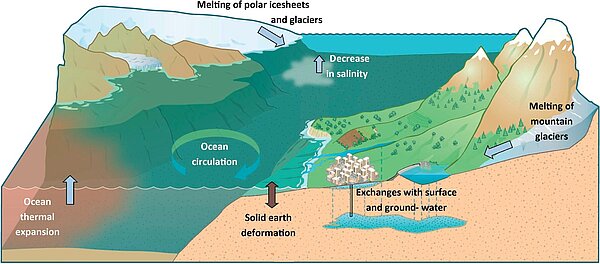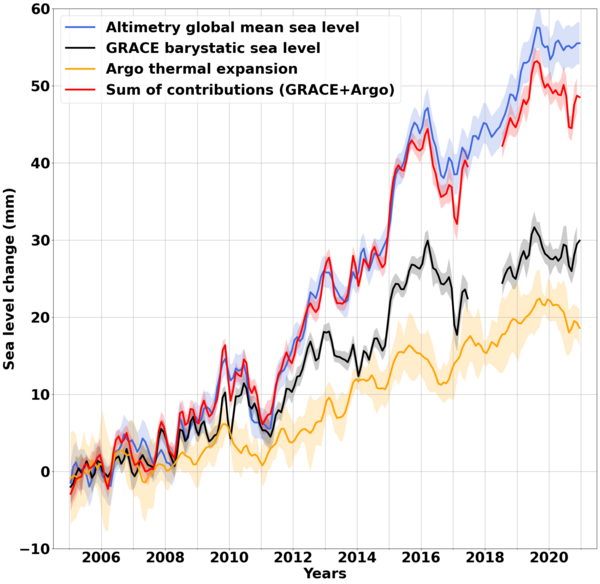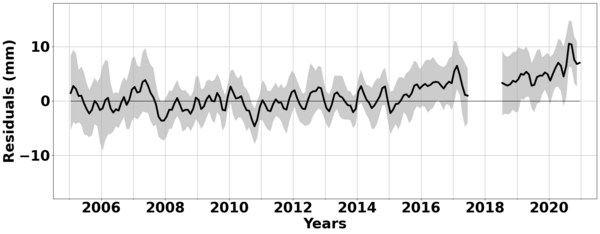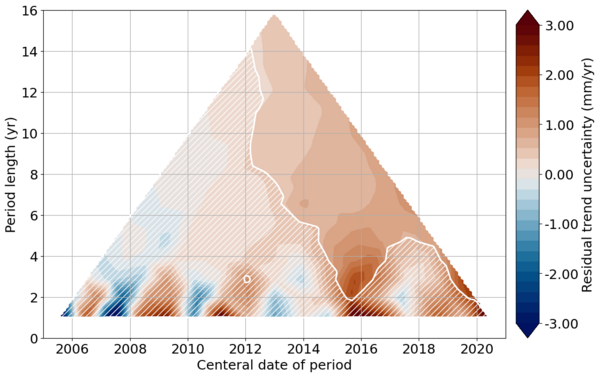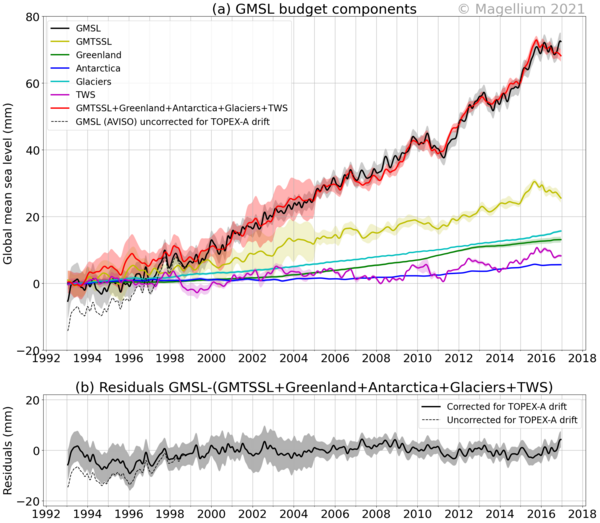The global mean sea level budget
The global mean sea level (GMSL) budget is a powerful tool to assess the consistency of the observing systems used to estimate sea level and its contributions. This page provides an overview of the GMSL budget and its potential as a Cal/Val method for altimetry. Links to sea level budget data are provided at the end of this page.
The global mean sea level budget
The sea level budget states that the GMSL change is the sum of the barystatic component due to variations of mass of the ocean (input of freshwater from the continents, including land ice melt) and of the steric component due to variations in temperature and salinity of the ocean (respectively called thermosteric and halosteric components). The halosteric component is negligible in terms of global mean due to salt conservation, so that the GMSL change can be written as the sum of the barystatic and thermosteric components only.
| GMSL = barystatic + thermosteric + εa |
The barystatic sea level change accounts for the sum of water mass changes due to land ice loss from Greenland (ΔMGreenland), Antarctica (ΔMAntarctic) and glaciers (ΔMglaciers), terrestrial water storage variations (ΔMTWS) and changes in atmospheric water vapor content (ΔMAWV), with mass changes expressed as sea level equivalent.
| Barystatic = ΔMGreenland + ΔMAntarctic + ΔMglaciers + ΔMTWS + ΔMAWV + εb |
In the above equations, εa and εb stand for errors in the components and potentially missing contributions (such as permafrost melting). The main sources of sea level change are summarized in Figure 1.
Figure 1: Illustration of the main sources of sea level changes, from Cazenave and Le Cozannet (2013).
GMSL change is observed by altimetry (usually corrected for atmospheric loading and glacial isostatic adjustment). The barystatic component is estimated using data from the GRACE and GRACE Follow-on gravimetry satellite missions since 2002. The steric component estimate is based on in-situ measurements of sea water temperature and salinity down to a given depth (down to 2000 m depth with the Core Argo network since 2005).
Assessing the closure of the GMSL budget allows to check the consistency of the altimetry, gravimetry and in-situ observing systems. When residuals (i.e. the GMSL change minus the sum of the components) are significant with respect to their uncertainties, this means either that the uncertainties are underestimated, that systematic errors affect one or several observing systems (e.g. instrumental drifts of onboard systems such as the TOPEX-A altimeter or the Jason-3 radiometer wet troposphere correction) or that there are missing contributions in the budget (e.g. warming of the deep ocean below 2000 m not sampled by Argo, neglected halosteric contribution if the coverage of the data is not fully global).
Figure 2: GMSL budget comparing altimetry, GRACE and Argo data, updated from Barnoud et al. (2023). (a) Budget components. (b) Budget residuals. (c) Trends of the budget residuals as a function of time and period length. Hatched areas correspond to trends that are lower than their standard uncertainties, hence non significant trends. Non hatched areas correspond to time and periods over which the GMSL budget is not closed (in terms of residual trends with respect to their standard uncertainties).
Before the GRACE era, or in addition to GRACE data, the barystatic sea level change can be computed from observations or model-based estimates of each individual mass change contribution (as in Figure 3).
Over the altimetry era, the sea level budget approach has regularly revealed measurements problems, including in the altimetry record, as shown in the following example.
The sea level budget as a Cal/Val method: example of the TOPEX-A drift
Estimating the components of the GMSL budget over the altimetry era and looking at the residuals, Dieng et al. (2017) discovered strong discrepancy over 1993-1998 between the altimetry-based GMSL and the sum of components computed independently, while beyond 1998 the sea level budget was almost perfectly closed. They attributed the non closure of the early part of the record to the known drift of the TOPEX-A altimeter and estimated its contribution to the GMSL of 1.5 +/- 0.5 mm/yr over 1993-1998, in agreement with published values in the literature based on comparisons with tide-gauges (Watson et al., 2015; Ablain et al., 2017). Figure 3 shows the non-closure of the GMSL budget over TOPEX-A period using up-to-date data.
Figure 3: Comparison of the GMSL with the sum of the sea level budget components. Solid black lines: GMSL corrected for TOPEX-A drift with a linear correction of 1.5 mm/yr. Dashed black lines: GMSL uncorrected for TOPEX-A drift. Modified from Dieng et al. (2017), using the components provided by the SLBC_cci project (Horwath et al., 2022) and the GMSL vDT2021 from AVISO.
Sea level budget data
State-of-the-art components of the sea level budget for 1993-2016 are provided by the ESA Climate Change Initiative (CCI) Sea Level Budget Closure (SLBC_cci) project (Horwath et al., 2022) and are available at: http://dx.doi.org/10.5285/17c2ce31784048de93996275ee976fff
A new phase of the ESA CCI Sea Level Budget Closure (called SLBC_cci+) started in April 2023 for a 3-year duration (https://climate.esa.int/en/projects/sea-level-budget-closure/ ). Its objective consists of updating the global mean sea level budget and assessing the closure of the sea level budget at regional scale (i.e. ocean basin scale). The corresponding data will be published here as they become available.
References
Ablain, M., Jugier, R., Zawadzki, L., Taburet, N., Cazenave, A., Meyssignac, B., and Picot, N.: The TOPEX-A drift and its impacts on GMSL time series, in: OSTST meeting, October 2017, 2017.
Barnoud, A., Pfeffer, J., Cazenave, A., Fraudeau, R., Rousseau, V., and Ablain, M.: Revisiting the global mean ocean mass budget over 2005–2020, Ocean Science, 19, 321–334, https://doi.org/10.5194/os-19-321-2023 , 2023.
Cazenave, A. and Le Cozannet, G.: Sea level rise and its coastal impacts, Earth Future, 2, 15–34, https://doi.org/10.1002/2013ef000188 , 2014.
Dieng, H. B., Cazenave, A., Meyssignac, B., and Ablain, M.: New estimate of the current rate of sea level rise from a sea level budget approach, Geophysical Research Letters, 44, 3744–3751, https://doi.org/10.1002/2017gl073308 , 2017.
Horwath, M., Gutknecht, B. D., Cazenave, A., Palanisamy, H. K., Marti, F., Marzeion, B., Paul, F., Bris, R. L., Hogg, A. E., Otosaka, I., Shepherd, A., Döll, P., Cáceres, D., Schmied, H. M., Johannessen, J. A., Nilsen, J. E. Ø., Raj, R. P., Forsberg, R., Sørensen, L. S., Barletta, V. R., Simonsen, S. B., Knudsen, P., Andersen, O. B., Randall, H., Rose, S. K., Merchant, C. J., Macintosh, C. R., von Schuckmann, K., Novotny, K., Groh, A., Restano, M., and Benveniste, J.: Global sea-level budget and ocean-mass budget, with focus on advanced data products and uncertainty characterisation, Earth Systems Science Data, 14, 411–447, https://doi.org/10.5194/essd-14-411-2022 , 2022.
Watson, C. S., White, N. J., Church, J. A., King, M. A., Burgette, R. J., and Legresy, B.: Unabated global mean sea-level rise over the satellite altimeter era, Nature Climate Change, 5, 565–568, https://doi.org/10.1038/nclimate2635 , 2015.




















